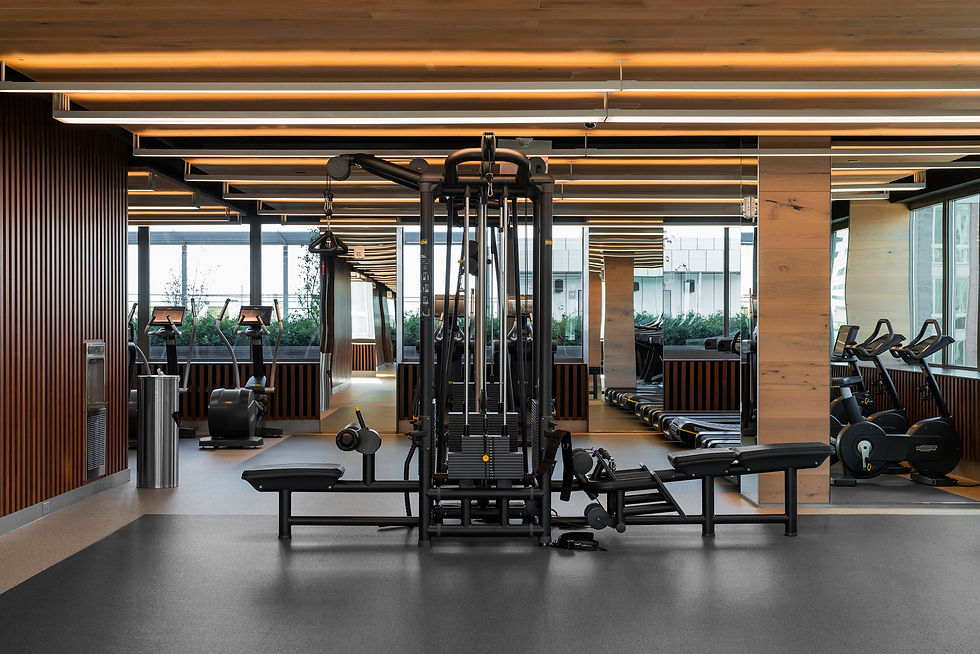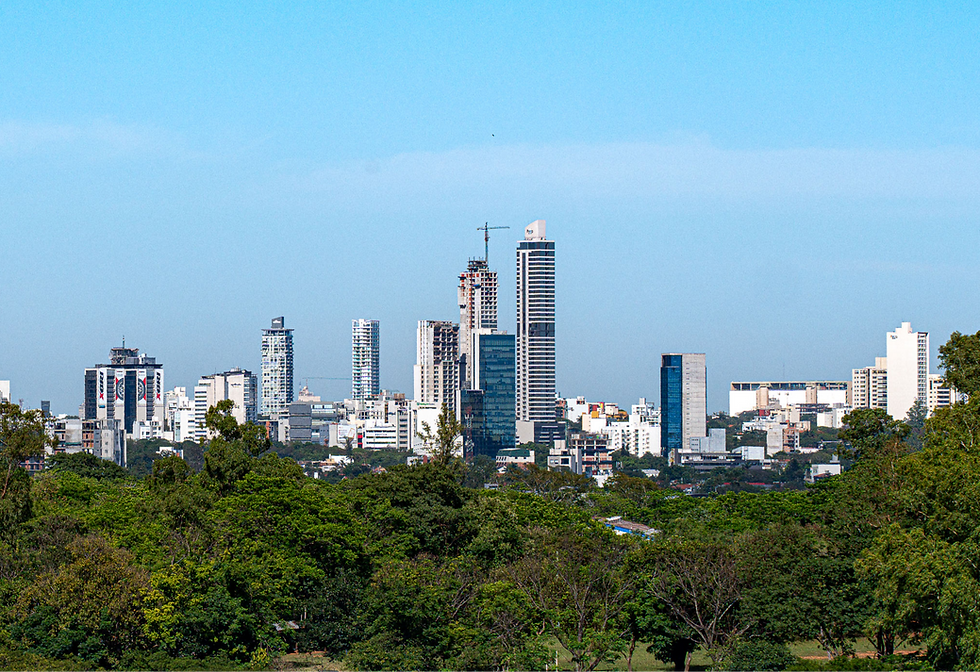Is There Real Estate Oversupply in Asunción?
- Gonzalo Faccas

- Jun 10
- 7 min read
Updated: Jun 17
Although some reports warn of a possible saturation of the real estate market in Asunción, a closer look reveals that the sector is not facing an oversupply crisis, but rather a maturing process, where the key lies not in the number of units, but in the quality of the offerings and their ability to respond to new ways of inhabiting the city.

In December 2024, Forbes Paraguay published an article titled "Risk of Real Estate Oversupply: Developers Could Halt Investments ," which warns of a potential oversupply of new units in the Asunción market and warns that this situation could discourage new investment in the sector. According to data cited in the article, 289 buildings are expected to be delivered in the next three years, which, according to some analysts, could lead to market saturation and a decrease in profitability.
While it's true that any dynamic market requires attention to the balance between supply and demand, proposing a vision of imminent widespread oversupply is, in our opinion, a partial and incomplete interpretation of the current real estate situation in Asunción.
The local context, the characteristics of demand, changes in consumer lifestyles, and Paraguay's positioning on the regional and global stage show that the market is far from being in a state of structural crisis.
Rather than a risk of uncontrolled oversupply, what we face is a process of maturation and sophistication, where solid, well-located, and well-thought-out projects will continue to find demand, while a lack of differentiation could penalize some developments less suited to new demands.
Below, we share a different perspective on the current state of the real estate market in Asunción.
Understanding “oversupply” requires analyzing quality, not just quantity
When talking about the risk of oversupply in the real estate market, a basic mistake is often made: assuming that all new units compete equally. However, in more mature markets—and Asunción is on its way to becoming one of them—not all products are equal, nor does all new supply have the same impact.
The number of buildings under construction or close to delivery does not, in itself, reflect the true dynamics of demand. There is a natural market segmentation: a premium building in a strategic location is not the same as a generic development in an area with poor connectivity or no services. Nor is a unit designed for investors seeking immediate income the same as one designed for young end-users who prioritize amenities, location, and quality of life.
A concrete example of how a project can add many units without saturating the traditional market is Marena , a real estate development that incorporates, in the heart of the city, a large crystalline lagoon as the central axis of its proposal.
Marena doesn't simply offer apartments: it offers a completely different concept of living. The project doesn't compete directly with the traditional offering of standard apartments in Asunción because it appeals to different aspirations, different lifestyles, and, consequently, different types of demand. The fact that it incorporates many units doesn't mean it increases the oversupply in traditional segments; it means it creates a new micro-segment, with a product that didn't previously exist on the market.
Talking about oversupply in absolute terms ignores this type of innovation. Many new developments don't overwhelm existing offerings, but rather expand the available options, responding to needs and desires that until then had been underserved.
Therefore, the challenge for developers is not to indiscriminately curb investment, but to invest intelligently: thoroughly understanding new consumer habits, the priorities of today's customers, and the real value of each location in an urban context that is also evolving.

We already experienced this debate: the déjà vu of 2016
This concern about a supposed oversupply of real estate in Asunción is nothing new. Personally, I'm clearly experiencing déjà vu. In 2016, when new corporate office buildings began to be delivered in the city, a very similar alarm arose in the market.
At the time, many argued that Asunción would face a structural oversupply of corporate space, which would severely impact investor returns.
In December 2016, I wrote an article titled "Is There an Oversupply of Corporate Offices in Asunción?" , which analyzed this issue in depth. My conclusion was clear: we weren't facing a generalized crisis, but rather a process of change and professionalization of the market.
In fact, as time has shown, far from collapsing, the office market has evolved positively: new high-demand areas have emerged, the quality standards demanded by users have increased, the supply has become more professional, and Asunción has strengthened its position as a competitive regional location for corporate headquarters.
Today, almost a decade later, we see that those predictions of massive saturation not only failed to materialize, but the city actually strengthened its business and real estate ecosystem.
The market did not disappear: it transformed and raised its level.
This background teaches us something fundamental: real estate markets are not static. They adapt, evolve, and naturally filter out projects that best understand and respond to changes in demand. A simplistic interpretation based solely on absolute numbers of new units ignores the market's true absorption capacity and its tendency to correct itself through quality, innovation, and professionalization.
Urban densification as a response to the traffic challenge in Asunción
In 2019, I published an article titled "The New Luxury of Working in a Well-Located Place in Asunción," where I analyzed how the strategic location of workspaces was becoming a determining factor in citizens' quality of life. Growing traffic congestion and the lack of efficient public transportation alternatives were transforming proximity to the workplace into a true luxury.
Asunción faces a structural challenge: its low urban density compared to other South American capitals. This dispersion forces citizens to travel long distances daily, increasing car use and, consequently, the pressure on urban traffic. According to official data collected in the 2022 Paraguayan census, Asunción has approximately 462,000 inhabitants, while its metropolitan area exceeds 2.3 million people, accounting for nearly 70% of the national GDP.
The solution lies not in halting real estate development, but in promoting smart densification that allows more people to live close to their workplaces, schools, and essential services. Well-located and comprehensively designed projects can significantly contribute to reducing car dependence, improving urban mobility, and, consequently, improving citizens' quality of life.
We are convinced that all developments close to the centers where people work will continue to enjoy sustained demand. It's not simply about convenience; it's about quality of life. Shortening commute times, reducing traffic stress, and gaining more time for family, leisure, and rest has a direct impact on people's well-being. This trend, which has already been consolidated in major cities around the world, will also become more established in Asunción as we evolve toward a more integrated and efficient urban model.

New lifestyles and emerging demand
The demand for real estate in Asunción, as in many other cities around the world, is changing rapidly. It's no longer just about acquiring a property as a basic need or a traditional investment: people are increasingly looking for projects that offer them a lifestyle.
Today, buyers and users value aspects that just a few years ago weren't central to their decision-making: proximity to work, amenities that improve daily quality of life, efficient spatial design, security, connectivity, and access to services without having to travel long distances. The concept of "strategic location" is no longer a luxury reserved for a select few: it's a real necessity that defines the perceived value of a property.
In this sense, many of the new developments in Asunción are not competing simply on quantity, but on value proposition. Projects like Marena , which integrate nature, first-class amenities, and a prime location, aren't fighting for a place in a market saturated with homogeneous offerings; they're responding to an emerging demand for better living.
Furthermore, generational change is accelerating this transformation. New generations—millennials and centennials—prioritize time, experience, and well-being over simply owning square footage. They prefer to live in more functional and better-located spaces, with access to services and activities that fit into their lifestyles.
In this context, demand does not disappear: it is redefined.
And projects that understand this change will not only avoid the impact of a supposed oversupply, but will also be better able to capture and retain these new consumers. Viewing the market solely from the projected number of units is a mistake. What defines the true dynamics of the market is not how many units exist, but how many genuinely respond to users' new needs and expectations.

The market is not facing a collapse, it is facing a maturation
The current dynamics of the real estate market in Asunción should not be interpreted as the beginning of a crisis, but rather as a sign of maturity. When a market evolves, it does so with increasing demands: better locations, better design, and better living experiences.
It's no longer enough to simply build square footage: we must create real value for the end user. This will also be highly valued by investors, who represent a large portion of the market, who will rent or resell to those end users.
The eventual "natural selection" of projects is not a sign of collapse, but rather an inevitable and healthy step toward a more competitive, more professional, and more responsive market.
Projects that fail to understand new consumer behaviors, that fail to add real value, or that are not strategically located will likely face greater challenges. But those that correctly interpret the moment—and focus on quality, location, and lifestyle—will continue to find sustained and solid demand.
Therefore, rather than fearing a supposed oversupply, we must focus on promoting developments that improve the city, optimize the use of urban land, bring people closer to their workplaces, improve the quality of life, and contribute to building a more efficient, connected, and livable Asunción.
We're not facing a saturated market; we're facing a market that's learning to make better choices. And that, far from being a threat, is a huge opportunity.
The real risk isn't building too much. It's building without purpose.
If you're interested in learning more about Marena and exploring this new way of living in Asunción, please fill out the form and a representative from the developer will contact you.


